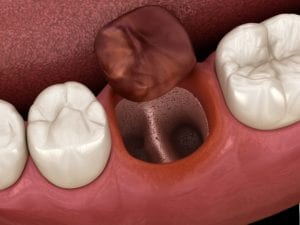Everything You Need to Know About a Dry Socket

Tooth extractions are performed when one or more teeth poses an oral health threat to the surrounding structures. Teeth can be extracted due to damage or decay, but wisdom teeth are also often extracted because they don’t fit properly into the mouth. After one or more teeth are extracted, there is a possibility that one can develop what is known as a dry socket, or alveolar osteitis. Here is everything you need to know about a dry socket:
What is a dry socket?

In the simplest sense, a dry socket is a dislodged blood clot. When a tooth is extracted from the bone and gums, the body will naturally form a blood clot in the hole left behind. This blood clot then protects the underlying bone and nerves. However, in some cases, a blood clot may fail to form or it may become dislodged. When this happens, the underlying bone and nerves are exposed.
How do I know if I have a dry socket?
The most common sign of a dry socket is a deep, throbbing pain. Pain often occurs in the jaw on the side of the extraction, however it can also spread to the ear, eye, temple, or neck. You may also experience bad breath or a bad taste. In some cases, you may even be able to look in the mirror and see the exposed bone. Being able to see exposed bone where your tooth used to be means you have a dry socket.
What do I do for a dry socket?

If you think that you may have a dry socket, you will need to call your dentist and schedule an appointment. Your dentist will first need to examine the extraction site for signs of infection, then they will usually clean the empty socket. Once the socket has been cleaned, your dentist will pack the socket using gauze and a medicated gel or liquid to relieve pain and prevent infection. As they are packing the socket, they will likely explain how to clean and pack the socket so that you can do these things on your own at home. In most cases, a dry socket will heal within a week of the extraction.
Can I prevent a dry socket?
Currently, the exact cause of dry sockets is still being researched, so there is no for sure way to avoid them. However, there are a few things you can do to reduce the risk of developing a dry socket. These things are usually mentioned in the postoperative instructions provided to you by your dentist after your extraction. Basically, you will want to avoid dislodging the clot by avoiding vigorous activity, smoking, and drinking from a straw. Additionally, following guidelines on what to eat and drink, as well as how to keep the extraction site clean are also important ways to prevent a dry socket. Yet, there are some individuals who may be at an increased risk for developing a dry socket, such as those who have had one before, who smoke or use tobacco, or who are on oral contraceptives. This is because tobacco use causes healing to be delayed, while oral contraceptives contain high levels of estrogen that can affect the healing process.






Recent Comments